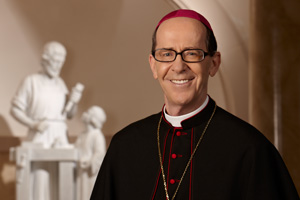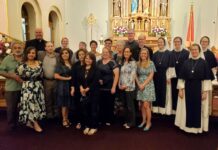Singing the Mass — Part Four
In the first three parts of this series we have explored the meaning of sacred music, the Church’s role in preserving and fostering it, and its role in evangelizing culture. Now, in this fourth and final part of the series, we discuss practical ways to deepen our use of sacred music for greater participation by all the faithful.
EN ESPAÑOL: Puntos prácticos para cantar la Misa
What to sing at Mass

The General Instruction of the Roman Missal (GIRM) describes the importance of singing in the sacred liturgy and offers practical considerations. In article 40 we learn that “in the choosing of the parts [of the Mass] actually to be sung, preference is to be given to those that are of greater importance and especially to those which are to be sung by the Priest or the Deacon or a reader, with the people replying, or by the Priest and people together.”
But how are we to know what parts of the liturgy are of greater or lesser importance? Musicam Sacram, cited in the GIRM, provides a useful instruction on just this question, dividing into three degrees the parts to be sung in the Mass to help “the faithful toward an ever greater participation in the singing” (cf. MS 28-31).
The first degree consists essentially of the Order of the Mass (the chants sung in dialogue between the priest or the deacon and the people). The second degree consists essentially of the Ordinary of the Mass (Kyrie, Gloria, Credo, Sanctus, and Agnus Dei). The third degree consists essentially of the Proper of the Mass (the chants sung at the Entrance, Offertory and Communion processions, and the Responsorial Psalm and Alleluia with its verse before the Gospel).
The Order of the Mass
The Order of the Mass is the fundamental and primary song of the liturgy. It forms the part of the Mass that is of the greatest importance, and therefore it should be sung ideally before any of the other parts of the Mass are sung. When the Order of the Mass is sung, the liturgy becomes most true to itself, and all else in the liturgy becomes more properly ordered. The Order of the Mass is set to be sung in our new English edition of the Roman Missal. I strongly urge all priests and deacons to learn these chants and to encourage and inspire the faithful to join in their singing with love and devotion.
The Ordinary of the Mass
The Ordinary of the Mass, comprising the chants of the second degree, is also of its nature meant to be sung. The Ordinary of the Mass consists of two penitential litanies, two hymns of praise, and the Church’s great profession of faith, which are fixed within the Order of the Mass and, depending on the demands of the liturgy or season, form a part of the unchanging structure of the Mass.
While the Kyrie, Gloria, Credo (Creed), Sanctus and Agnus Dei may be sung to a variety of musical settings, the Church’s great sacred music tradition has handed down to us an inestimable treasure of chants for the Mass Ordinary. The recent English edition of the Roman Missal itself has given us a “standard” musical setting of the Ordinary in the form of simple English and Latin chants, including musical settings of the Creed. While the Ordinary of the Mass may be sung in the vernacular, the Second Vatican Council mandated that “steps should be taken so that the faithful may also be able to say or to sing together in Latin those parts of the Ordinary of the Mass which pertain to them” (Sacrosanctum Concilium 54).
The Proper of the Mass
The Proper of the Mass, comprising the chants of the third degree, form an integral, yet often overlooked part of the sung liturgy. The Proper of the Mass consists of three processional chants and two chants between the Lectionary readings. These parts of the Mass, contained in the Roman Missal and Graduale Romanum, are unlike the Order of the Mass and the Ordinary of the Mass in that they are not fixed and unchanging from day to day, but change according to the liturgical calendar, and therefore are “proper” to particular liturgical celebrations.
Here we find the Entrance Antiphon, Responsorial Psalm (or Gradual), the Alleluia and its Verse, the Offertory Antiphon, and the Communion Antiphon. While the Proper of the Mass is subordinated in degree of importance to the Order of the Mass and the Ordinary of the Mass, the texts of the Mass Proper form perhaps one of the most immense and deeply rich treasure troves in the sacred music tradition. Because these texts change from day to day, they were historically sung by the schola cantorum, and, because of their demands, are sometimes replaced today by other seasonal or suitable options.
The texts of the Proper of the Mass, especially the Entrance, Offertory and Communion chants, are comprised of scriptural antiphons and verses from a psalm or canticle. This is the form of the texts given in the Roman Missal, the Graduale Romanum, and the Graduale Simplex, the Church’s primary sources for the Proper of the Mass. The GIRM also allows for the possibility of singing chants from “another collection of Psalms and antiphons, approved by the Conference of Bishops or the Diocesan Bishop” during the three Mass processions, and, lastly, allows for the singing of “another liturgical chant that is suited to the sacred action, the day, or the time of year, similarly approved by the Conference of Bishops or the Diocesan Bishop” (Cf. GIRM 48, 87).
The texts of the Proper of the Mass, while of lesser importance than the texts of the Order of the Mass and the Ordinary of the Mass, form a substantial and constitutive element of the liturgy, and I encourage a recovery of their use today. We are blessed to have in our day a kind of reawakening to their value. In addition, many new resources are becoming available that make their singing achievable in parish life. I strongly encourage parishes to take up the task of singing the antiphons and psalmody contained within the liturgical books, and to rediscover the immense spiritual riches contained within the Proper of the Mass.
I offer my heartfelt thanks to all pastors, priests, deacons, religious, and lay faithful who enthusiastically study, encourage, and seek new ways to implement sacred music in the life of the Church. This is an ongoing task, an essential part of authentic liturgical renewal since the Second Vatican Council, and a sure means of drawing many souls to the beauty of Christ, who invites us into His unending song of love to the Father.





![[VIDEO] Make Sunday feel like Sunday again](https://www.catholicsun.org/wp-content/uploads/2021/04/2021-YOUTUBE-BISHOP-MESSAGE-THUMBNAIL-ENGLISH-218x150.png)
